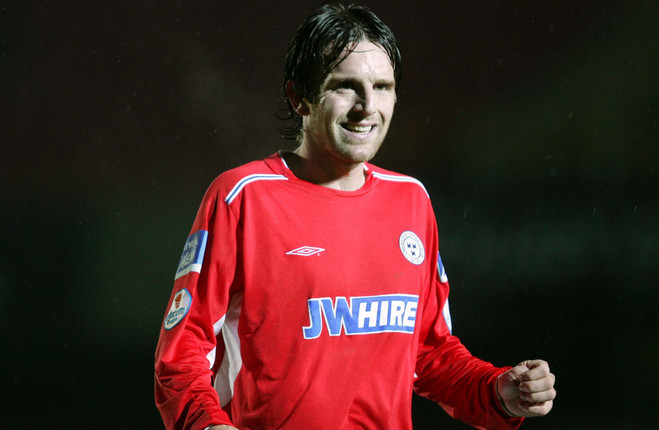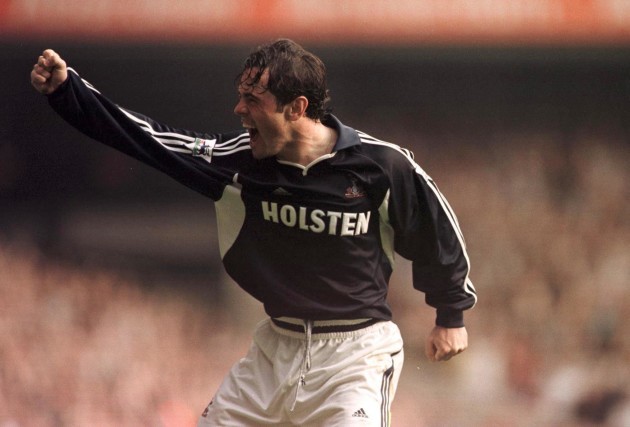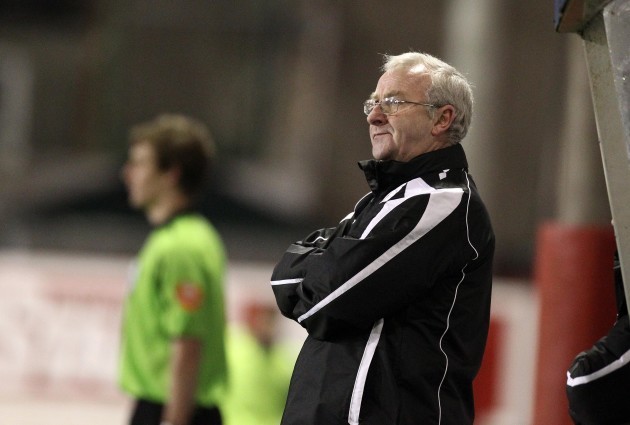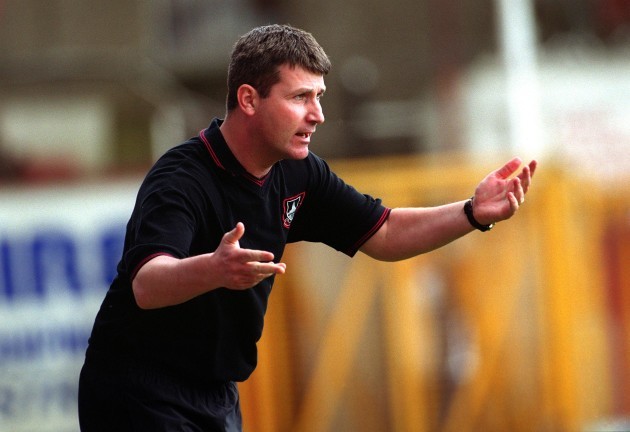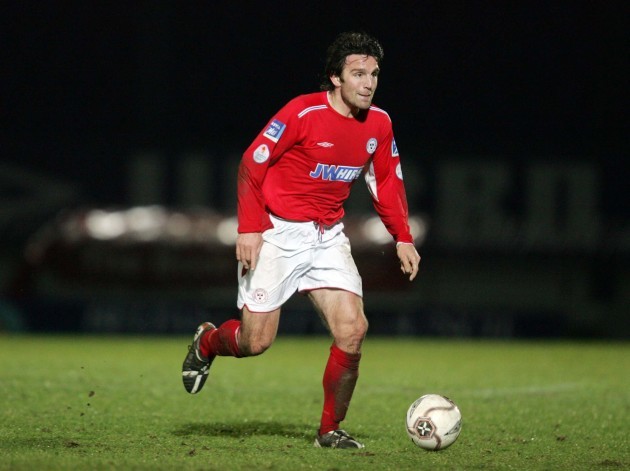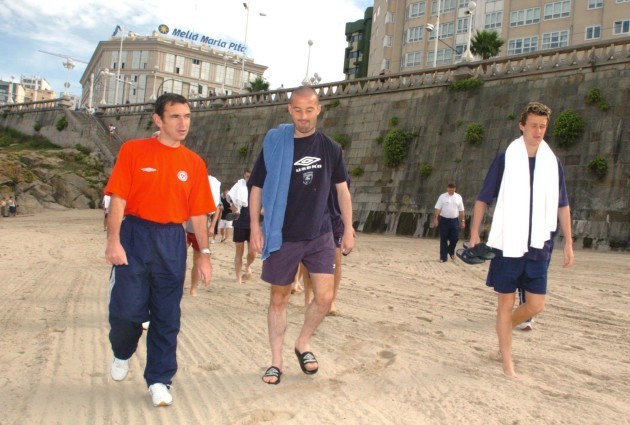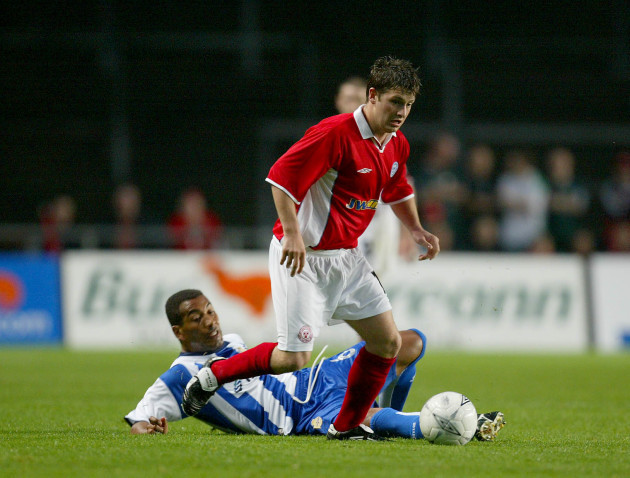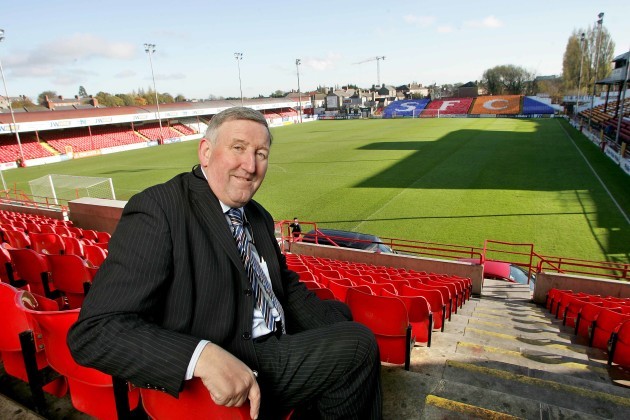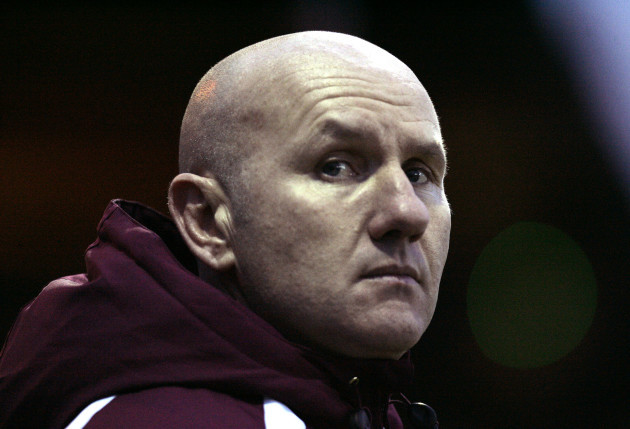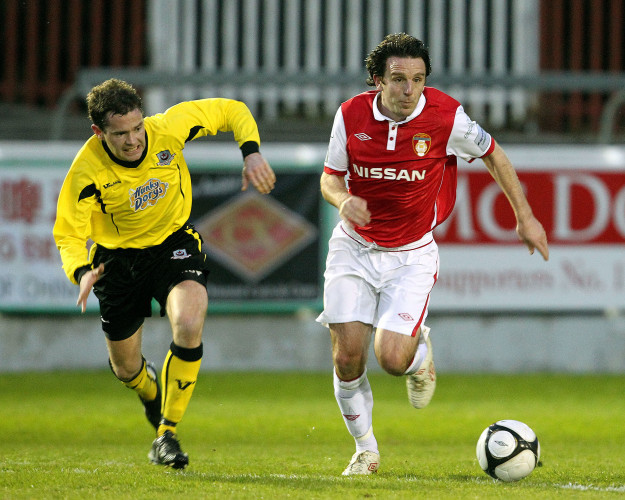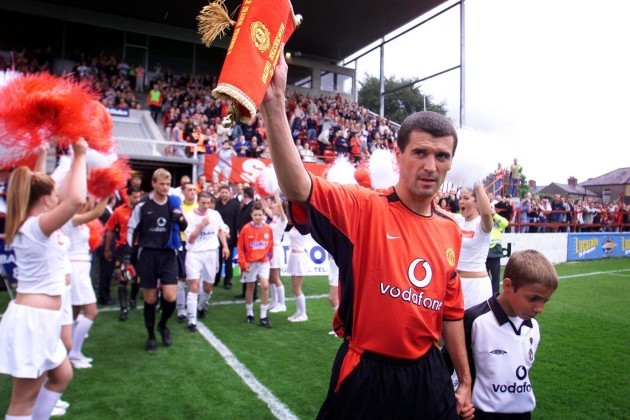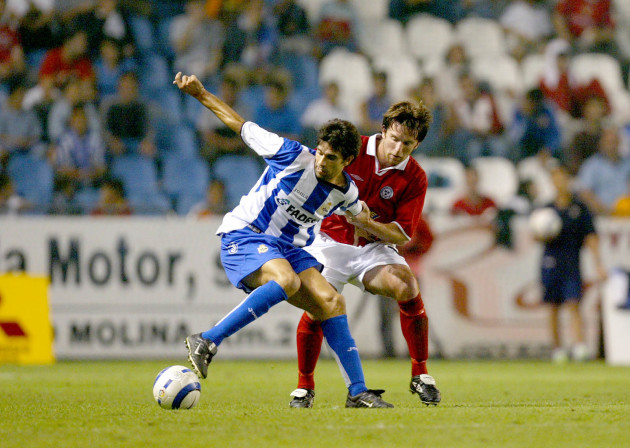WHEN LOOKING AT the top sides in the history of the League of Ireland, the Shelbourne team of the early-to-mid 2000s would certainly be up there.
The likes of Glen Crowe, Jason Byrne, Joseph N’Do and Wes Hoolahan either were or would become senior internationals.
Thomas Morgan had been part of the Brian Kerr-managed Irish team that finished third in the World Youth Championships.
Meanwhile, players such as Owen Heary, Ollie Cahill and Dave Rogers were top pros with an abundance of experience.
Yet just as fundamental to the team was Stuart Byrne, or ‘Stuey’ as he is affectionately known.
The hard-working midfielder was an integral part of a side that won three Premier Division titles.
There was also the famous TV interview where he lambasted then-Derry City boss Stephen Kenny, the man who also played a considerable role in reviving Byrne’s career by helping him develop as a youngster at Longford.
1. Starting out
Yet before all that, it is necessary to go back to the very beginning, the Home Farm mini leagues to be exact.
It was there in the early 1980s where Byrne fell in love with the game. The blitz tournaments would feature hundreds of kids split into various teams.
In addition to being a welcome initiative in the community, these events were used to help the club recruit the outstanding young players in the area. In addition to Byrne, a number of other future stars would wear Home Farm’s colours, including Richard Dunne, Kenny Cunningham and Stephen McPhail.
With a father who enjoyed marathon running and was a keen footballer, as well as a mother he describes as an “aerobics guru,” Byrne’s sporting pursuits were very much encouraged from an early age.
[My father] was always very hands-on with me as a kid,” he tells The42. “The one thing that always sticks out is he always encouraged me to play with both feet. He’d just tell me to inter-change — right foot, left foot.
“That’s probably the best piece of advice he gave me in terms of football, because it’s something I always carried in my career — I was always equally good on my left and right foot.”
A sign of Byrne’s ambitious nature was evident early on. Despite Home Farm being renowned as one of the top schoolboy clubs in the country, having played with them for a couple of years, he became disillusioned with the set-up there.
“The club was definitely in huge decline. I was very keen on at least trying to give myself a chance to go to England. When you’re 13-15, there are scouts coming to games and that sort of stuff. You do try to give yourself every opportunity to get over, even though luck is a huge part of it… Luck is about 90% of it.”
2. Dreaming of England
As a result of his frustration with the club’s perceived deficiencies, Byrne left Home Farm and moved to Stella Maris. Future League of Ireland stars Trevor Molloy and Glen Crowe were among his team-mates, though one player in particular was making waves.
“Stephen Carr progressed physically much quicker than anybody else did. He stood out a mile,” he recalls.
“At the time, we were 15 and 16, and you might think it’s your fault that you’re not more physically developed. But you know now, it’s not. Kids develop at different ages. That development can happen at nine or 10, or 17 or 18.
“I was probably a late developer. I never focused too much on football and what I was doing on the pitch until I was about 17 or 18.”
Carr eventually moved to England, enjoying a successful career with Tottenham and Newcastle among others. At one point, it looked as if Byrne might do likewise.
The late ex-Arsenal player Joe Haverty was the Gunners scout in Ireland at the time, and Byrne says the former Irish international recommended both himself and Glen Crowe to the London club. The latter player ultimately moved to Wolves, but Byrne stayed in Ireland.
“Nothing ever came of [the Arsenal talk],” he recalls. “Crowe-y went and that was it really.
There was always a lot of talk about this scout and that scout. There would have been occasions where scouts would have talked to parents. They just put the feelers out, I think.
“But that one incident would have been quite genuine. Joe would have gotten Stephen Carr over to Arsenal as a young kid as well. It seemed like something that was going to happen.”
3. An alternative career path
In that era, playing in the League of Ireland after dreams of English football had fallen through was not quite as an attractive an alternative as it appears to be for many young players now.
“At that stage, everybody else, in schoolboy terms, was starting to die off,” Byrne explains. “They didn’t get the move to England, so they were kind of giving up on it.
“The League of Ireland was very much an older scene. You had to be in your late 20s or 30s to be playing at that level, because they were all men.
“You’ve got girls and lads going out having a few beers in the pubs and nightclubs. Some lads start working, they don’t do their Leaving Cert, they start earning a few bob. It’s onwards with their new life and football is left behind.
“I was only starting to get the bug and be really serious about it when I was 17 or 18, so I was looking for somewhere to go. The England thing didn’t work out, so I was saying: ‘Where will I go next?’”
4. Learning his trade
The Dublin-born youngster’s coach at Stella Maris, Tom Kavanagh, was friendly with the Shamrock Rovers manager, the late ex-Ireland international Ray Treacy, at the time. It resulted in an agreement whereby Byrne, Trevor Molloy and Sean Kavanagh would play for Shamrock Rovers reserves on a Saturday before lining out with the schoolboy club on the Sunday.
“The old wooden RDS was a 20,000-seater stadium. It looked fabulous. There’d be no one at the game, you’d still hear the echo around the stands. So it’d be a good excuse to go down every Saturday and play at that level.
“You could be playing away games in Tolka Park or Dalymount. You’d be playing against top players because the way the reserve league worked at the time, there would have been regulars in the reserve side but there would have been players from the first team coming back from injury or suspension getting a run out.
So I was playing against top players: Paul Whelan, Pat Fenlon, Mick Neville. It was incredible for young players and you got a great respect for those players. It was a great learning curve. You played against older, much more physical, much more mature players. They didn’t shirk out of tackles back then. You had to learn how to protect yourself and you had to become very physical yourself very quickly.”
In the end, however, Byrne opted to sign for Bohemians, Rovers’ bitter rivals.
“The opportunity to go to Rovers was there, Trevor and Sean went to Rovers, but I went to Bohs. I cannot think why. I probably had a little bit of a distrust of Tom Kavanagh and his relationship with Ray [Treacy] for whatever reason.”
In hindsight, Byrne acknowledges the decision to go to Bohs was a mistake. With several more senior and established players ahead of him, he found game time hard to come by.
And while he endured a fairly miserable two years at Dalymount Park, the experience was not completely negative.
“I got very friendly with Tommy Byrne, Tony O’Connor and Maurice O’Driscoll. They were great lads and I still chat to them even now. Because there was a gap and they were so much older, those guys wouldn’t let you away with anything.
“It would put hairs on your chest fairly sharpish. They’d put discipline on you if you were out of line. You’d learn quickly to respect experienced players, even though you might have been quicker or fitter than them. You learned that youth and energy wasn’t everything. Experience and technique is just as important.”
5. An eye-opening moment
After the disappointing spell at Bohemians, Byrne linked up with Dermot Keely at Home Farm Everton. After some initial tension between the player and manager, their relationship flourished.
“I maybe thought I was a little bit too good for Home Farm. I needed to start over again, get my head down and play football. Immediately there was a conflict with Dermot, purely with his management style. I was still learning and getting my head around things. There were other things going on in my life personally.
“Dermot’s very much a no-nonsense disciplinarian, roaring and shouting. He’s very direct, wouldn’t let you away with anything. I’d say probably for the first half of the season, there were issues there. It eventually led to a bit of an argument in a game away to Galway.
“I was playing right side of midfield. I was having a bit of an issue playing there because I felt I was more of a central player. But in hindsight, it’s always good for a player’s development to play in different positions. But I didn’t know that at the time.
We were to-ing and fro-ing. I think he whipped me off after half-time. We were having a pop off each other. Dermot was probably thinking: ‘Who’s this fella? This 20-year-old kid. I’ve won multiple league titles as a player and manager.’ He was one of the top players in League of Ireland and he’s got this kid giving him lip.
“So I thought that was it, I probably won’t play again, he’ll try and get me out or whatever the case may be.
“Something happened in those couple of days. I said: ‘Do you know what? I was in the wrong. I pulled him aside in training and said: ‘I want to apologise for the other night.’ The second I said it, he was unbelievable. A completely different side of him came out — a modest management style. I couldn’t believe it. Now I know why Dermot was so successful — he could mix it, he could do the hard stuff but he could do the modest side of the game as well.
“Since that chat we had, I was a different player. Everything he asked me to do [I would do], that probably set me on my way to reboot my career. Otherwise I probably would have dwindled away and given it up.”
6. Northern exposure
Yet once Keely moved on to manage Shels, Byrne grew frustrated again. Under Mick Lawlor, he could feel his time at Home Farm starting to peter out.
A difficult spell followed where his career in the game appeared to be in the balance.
“I was 20,” he remembers. “Without going into it, there was a lot of personal stuff going on at home.
“Football was a great out. There was a lot of frustration coming out of me. I was trying to move on and progress things. I had a few weeks down at Bohs with Roddy seeing if I could make a move back there. I didn’t like it, I didn’t really like the set-up. I don’t think Roddy wanted me either, to be honest.
“The opportunity came to go up to Crusaders and play there for a few months. The Northern league at the time was probably as good as ours — it could even have been better. Pat Fenlon, Mick Neville, Paul Doolin all would have played there.
Crusaders had a wonderful set-up. Great stadium. You’re playing in top games against Linfield, all sorts going on on the terrace, bottles of Guinness being thrown onto the pitch. Now it seems a little bit too much, but it was great at the time — they’re fanatical about their football up north.
“Unfortunately, the training with a different team in Dublin and the personal stuff just blew up. I actually stopped for a few months, I took a break, I had to step away for a few months, and so I did. I totally stopped, needed to sort a few things out personally and didn’t know at that stage what was going to happen at all.”
7. The second coming
After a couple of months out of the game, Byrne received a phone call from Stephen Kenny, who was an inexperienced manager at Longford at the time.
They met in a pub near where Byrne was living in Swords and ultimately agreed a deal to take him to the club. Reflecting now, Byrne says Kenny’s offer might just have saved his career.
“Considering where my head space was at the time with the personal issues I was having, God knows what I would have done or where I would have ended up.
“I think [Stephen] was perfect for me. Among many of his strengths would be his ability to bring the best out of players who are maybe a little bit frustrated about things. He promotes the positive stuff, there was no negativity about him, you just wanted to play for him.
“That’s what good managers do. They have an aura and personality about them and a way of getting you to play for them — it’s as simple as that.
I’d go through a brick wall for him. And so it was just a positive move. It was the first time in my whole career and I’m even thinking going back to schoolboy, I felt good about the club I was playing for, I liked the manager, I liked the players and I had a much clearer picture in my head.
“I was very lucky as well. That Longford team was a hell of a team. When you look at what Stephen’s done in Dundalk, taking the players he’s taken and people very quickly forget this, the team Stephen [inherited] back in 2013, they were not household names, nobody would have seen what they turned out to be.
“But I’m not surprised by [Dundalk's success] at all, because he did that at Longford. Longford were a mishmash of players from here, there and everywhere. Some had come from the north, some had come from junior football, one or two had come from schoolboy football. But it was a hell of a team he put together. There were some super footballers, it was a great group.”
8. Longford in Europe
Byrne helped Longford punch significantly above their weight. In 2001, they reached the FAI Cup final but lost out to Bohemians, who also finished top of the Premier Division that year.
Despite finishing eighth in the league that season, their cup final appearance meant they qualified for the Uefa Cup.
The following campaign, they were paired in the draw with Bulgarian side Litex Lovech.
“Flancare had to be completely revamped for European football. In the space of a couple of weeks, the whole town came together and built this stadium. They built the whole three sides. The stand was only ever on one side. All of a sudden, it became this brand new stadium. Three new sides were added.”
Up against a higher standard of opposition than that with which they were accustomed to, Longford more than held their own. Having drawn the first leg 1-1 at home, Kenny’s side were unfortunate in Bulgaria, wasting a few good chances before two late goals ended their hopes of progression.
“You’d very much liken them to a mid-table Premier League team. They were very good — all 6’1, 6’2 — lean, fit and very comfortable on the ball.
We had youth, energy and a bit of quality and a very good team ethic. We ran them very close. I do remember we had opportunities over there and the away goal would have put us through.
“That was probably the first time where my mindset over the European experience [changed]. No one ever gave us a chance. People would constantly talk about the huge divide in technical ability. We were always putting ourselves down — even the players would be doing it. The commentary was constantly ‘we don’t stand a chance, we’re not not good enough,’ it used to drive me up the bloody wall.
“That experience told me in my own head ‘we’re not a million miles away’. It’s just our mindset is in the wrong place. The ability is there.”
That near-miss was as good as it got for Byrne at Longford. Shortly thereafter, Kenny departed to become manager of Bohs. The club struggled as a result, and needed to overcome Finn Harps on penalties in a play-off to avoid relegation to the First Division.
“I knew I was leaving and wanted to leave the club on a high. Purely for the supporters because they were fantastic — look at what they did for the stadium during that period in Europe and how they all came together… You didn’t want to leave the club in the First Division.”
Having impressed at Longford, Byrne was in demand. Four clubs were vying for his signature — St Pat’s, Shelbourne, Bohemians and Shamrock Rovers.
9. The start of something special
For a while, it looked as if the midfielder was set to be reunited with former boss Kenny.
“When you don’t have an agent, trying to speak to four clubs is not easy,” he says.
“So I brought Tom Conway in from the PFAI to see if he could negotiate it. I couldn’t deal with it anymore. I was getting phone calls every day in work and it became very difficult.
“The natural progression would have been to follow Stephen, but I had a thing in my mind about Shels. I can remember playing against them a couple of times in the League Cup at Home Farm and Longford as well in the league. Shels were streets ahead of everyone else in terms of professionalism. Players always looked the part, they were trying to do things properly on the pitch, they were wearing the best of gear, the Umbro stuff. They just looked professional and that kind of swayed me.
“Dermot [Keely] had stepped away for personal reasons during the months I was in talks. His father passed away, he stepped down from the Shels job and Pat had been given it. I didn’t know what would happen. Pat gets the manager’s job and what does he want to do? Does he want to sign players they had been speaking to or does he say ‘I don’t want them at all’. But he was onto me straight away, wanting me to sign. And that was it for me. This was Pat Fenlon, the best midfielder in the league that I had seen. We were probably similar players at the time. So as soon as that happened, it was a no-brainer for me.”
With Byrne at the heart of the midfield, Shels were invariably the best team in the Premier Division, winning the title in 2003, 2004 and 2006.
We were way ahead of other clubs at the time. We were very professional. This was 2001. We’d gone full-time. We were doing the strength and physical conditioning, the nutritional stuff. We didn’t have the stuff that’s available in this day and age.
“You didn’t want to be injured, because if you were injured, you were working twice as hard.
“Tolka Park was a fantastic place to play — it was a 10,000-seater stadium. The place was hopping. Because we were doing so well, we were getting gates very similar to what Cork would be getting now. So everything about the club was professionalism and ambition. That was mainly driven by Pat. The European stuff was talked about for years before we had even progressed to where we did in 2004. It was all leading up to that.
“Pat had [good] man-management skills. He also had this encyclopedia of soccer knowledge, because he had played at the top level. He played in England with Chelsea, he was a top player, who had a bit of everything. You just wanted to play for him and you bought into what he was trying to do with the club.
“Rosenborg were constantly talked about. When we played Rosenborg, that turned everyone’s head. How can a club from a town in Norway, Trondheim, with a population of around 200,000 people, how can this club suddenly be regulars in the Champions League? Maybe that was the inspiration for Shels to try to repeat that or at least move in that direction.
“Everyone bought into it — the supporters bought into it, we bought into it, and it was the reason why we qualified for the qualifying round of the group stages, because we believed we could do it and very nearly did [get to the group stages].”
10. Deportivo dilemma
A clear highlight of that period were the two Champions League qualifying games in 2004 against a Deportivo side that had reached the semi-finals of the competition the previous year before losing out to Jose Mourinho’s Porto 1-0 on aggregate.
The level of hype and excitement in the build-up to the match was something that Irish domestic football had arguably never experienced before.
“The week in the lead up to the Lansdowne game, Sky Sports were following us around. You’re going to press conferences every day, you were training in Lansdowne three days prior to get used to it. We’d only been to Lansdowne to watch Ireland play.
And just everything that went with it, it was top stuff. When we were playing in the game, we set out for a couple of kilometres in the lead up to Lansdowne, and we saw people walking around in Shelbourne jerseys, and even Bohs jerseys and Cork City jerseys and Derry City jerseys. This wasn’t just a normal game, the country were coming out to support us and see if we can go through. It was an incredible feeling.
“It hadn’t been done. I know there were great results in Europe, but nothing like this level. And what was at stake was a place in the Champions League. That was the talk, we were constantly joking to each other about what it means to you. The football stuff speaks for itself, but we’d have been mortgage-free with the money that would have been going around at the time [for qualification to the group stages].”
Few if any people gave the Irish team a chance, but they held their own against one of the top sides in Europe. Having drawn the first leg in Dublin 0-0, they kept the tie scoreless and had a few chances in the first half at the Estadio Municipal de Riazor. Ultimately though, the Spaniards’ class told, and they ran out 3-0 winners.
Shelbourne had lost the tie but they had won plenty of admirers in the process.
“It goes back to what I mentioned earlier in relation to Litex Lovech with Longford. The psychology of it is huge. What I learned from that experience in 2004 is that when you play against better players, you become a better player. When the pressure gets higher, you deal with it.
We also built towards that game. Played Reykjavik two legs, played Hadjuk Split two legs, and all along we were getting more confident, more comfortable playing at this level, more comfortable dealing with the hype and the attention. You’re starting to feel it now, you’re taking things onboard, you’re eating better, you’re taking your off-field life much more seriously, getting rest during the day, you buy into it, you start to believe it, you get much more confidence, the higher the stakes, the better you can cope with it.
“In the past, I would constantly talk about: ‘Why aren’t the League of Ireland players in the international team?’ I completely believe that the good players will adapt to the environment. They’ll sink or swim. And they can make that leap, it’s just that they’re not being given a chance to do it. I think we proved that we were good enough – it’s just that we weren’t playing at that level enough. If we were playing at that level week in week out, we would be at that level. We could make the step up – it’s just that we weren’t doing it regularly enough.
“So what I took away from that experience was that we were good enough. We had the players that were good enough. We just don’t get it regularly enough. That’s the gap we have and that’s the gap we need to fill.”
11. A boy named Wes
In addition, over the course of the two ties, a star was born. Future Norwich and Ireland star Wes Hoolahan, who Byrne describes as the best player he ever played with, was known as an obvious talent among League of Ireland watchers long before then, but the performance in front of a national audience against top-class opposition seemed to serve as confirmation that he was destined for great things.
“I was a midfielder and he was playing in front of me with Alan Moore. I’m looking at this kid going ‘holy Jesus,’ it was just incredible. He was just a kid playing in front of 27,000 people – we couldn’t get any more into Lansdowne because it was restricted, but it was fantastic to watch him.
I’m not surprised by what he went on to do, I’m more frustrated to be honest, because it took too long for it to happen. And even when it did happen and he got into the Ireland team, Wes got 43 caps, but you’re kind of going ‘this kid should have got 80 or 90 caps,’ that’s what you’re feeling. You don’t like to have regrets about football and I’m sure he wouldn’t, he wouldn’t be that kind of person. On the one side, you’re delighted he finally got away and played in the Premier League. So I’d say he showed people most of what he’s about, but we missed out on a lot of Wes, we really did. We have a very negative approach to football in this country and to what we think our footballers should be.
“Wes was very much hindered by the fact that ‘you had to be 6’4’ and physical. Total nonsense. Because of that mentality, we missed on a wonderful player. We got to see the best of him, but we didn’t see enough of it unfortunately.”
12. A nightmare scenario
After hitting these remarkable heights, Shelbourne found themselves on the brink of collapse just two years later.
The 2006 season could hardly have been much more dramatic. There were financial issues among other problems behind the scenes, and the players knew about it — some more so than others.
“The players that Shels had, no one wanted to leave, they just loved the place. The things we experienced two or three years prior to that were things that only happen once in a generation in Irish football.
“Players tend to bury their head in the sand a little bit when it comes to the financial stuff. Some of them don’t like the conflict, but you’re a professional footballer, you do have to get on with it.
“In 2006, when the financial stuff hit home, it was very difficult for everybody, because we weren’t getting paid from pre-season. We kept it in-house for a long time, it didn’t really get out at all. The players wanted to deal with it internally.
“If a player wants to leave, you’ll see stuff coming out in the papers very quickly.
We wanted to win that league, because we pretty much made a hash of 2005 [finishing third]. We took that one on the chin. As players, we let ourselves down and just got things wrong for whatever reason.”
The stress of this situation was not helped by a further controversy. Dublin City went out of existence during that season. It meant that all games involving them were rendered irrelevant. Shels had beaten them twice, picking up six points in the process. Meanwhile, their title rivals Derry City had played the extinct club once that season and lost. So while Derry’s points tally was unaffected, Shels were docked six points, leaving the Dubliners incensed at this perceived injustice.
Yet despite feeling like “everything was conspiring against us,” the Dublin side overcame bitter rivals Bohemians 2-1 in Tolka Park on the final day, winning the league and finishing ahead of Derry City on goal difference in the process.
13. Victory from the jaws of defeat
Byrne cites another League of Ireland Legends piece with Kevin McHugh in relation to that period, rejecting claims made by its subject that Derry were hard done by.
“It was a great article and Kevin’s a great fella I have to say, but I remember reading his side of 2006 and he was going on about the games that Derry had been playing at the time and felt that hindered them in the eventual league. But I can tell you now, no one was going to win that league other than us. And that’s something I took very personally myself. I had bought into it an awful lot.
“During the season when we were constantly to-ing and fro-ing with the club as regards finance and that kind of stuff, Owen Heary, myself and one or two of the other lads were constantly involved, because we were the experienced players. It was very mentally draining.
None of the lads would talk to Ollie Byrne, because Ollie was mad. Ollie had this aura about him, he would tear you apart if you didn’t know him and didn’t know how to get around him or you couldn’t articulate well or argue well with him, because he was a very intelligent man. Ollie could have been a solicitor in another life. So not too many people would approach Ollie. Owen, myself, Pat and one or two others were really the only people who could do it.
“I knew the financial stuff was falling apart. Other players might not have known it. Four or five of us knew it, because we were dealing with it a lot.
“We wanted to leave on a high and win that league. I got very involved. The Bohs game in Tolka Park, I remember driving down and this is the clearest game [memory-wise] I probably ever had in my career.
“I had more focus and more confidence that we were going to win that game. I remember being very calm driving down. I wasn’t nervous at all and just knew we were going to win it. Things couldn’t have gone any worse for us in the first 20 minutes. It was a corner and Barry Ferguson had a tap in. It was one of them where the corner is coming in, the goalkeeper’s going up to catch it and you turn away, because you think he has it in his hands. And then you hear the big roar. I turned around and the ball is in the back of the net. It was ‘what happened?’
“But because of how focused we were at the time, we didn’t let it get to us at all. We had a penalty 10 minutes later, put it into the back of the net and brought it back to the halfway line. It was: ‘Let’s get the second.’ We did and it was what we deserved. It was a relief to get it over the line and get it done. So I left that season with another medal, even though the financial stuff had fallen apart.”
14. THAT interview
The league triumph also led to another memorable moment. Almost 12 years on, the phrase “I’m angry, Tony,” has become part of the lexicon of any self-respecting League of Ireland fan.
It was the post-match interview following the league title win when all of the frustration of previous months poured out of Byrne. Nowadays, he bears no ill will towards Stephen Kenny, but he could not help but criticise his former manager at the time.
Part of what makes it resonate with people to this day is surely to do with the fact that it was the antithesis of most match post-match interviews, when players try their best to be as diplomatic and uncontroversial as possible.
“I think there’s not enough of it in the sport,” he says. “It was a very emotional game and the supporters like to see emotion. I was hugely emotional myself. A lot of it I could control. A lot of it I didn’t want to control.
“I thought it was important that I tried to defend the club as much as I possibly could. It was: ‘Do you know what? I’m going to say a few things here?’ And you don’t see enough of it.
“A lot of the interview stuff is awful garbage. I don’t know why they even do it anymore. What are they telling us? But from that interview, I’d like to think I told a lot of people a lot of things.
Ollie rang me the next morning. I’ll always remember this, because it wasn’t too long after that, Ollie passed away. He rang me and said: ‘Look, I want to thank you so much for last night.’ He felt that for a long time, he was trying to get that message out there, but no one cared. He wanted to thank me for it and felt that at least the players had his back.
“The financial stuff aside, these were the decisions that were going against the club internally in terms of the off-the-field things. I just think he felt we had his back, we won the league for him and he rang me just to say thanks.
“I had to deal with a barrage of phone calls after that. Derry City fans were ringing me in the middle of the night absolutely hammering me. It actually became quite funny in the end.
“You’d get phone calls at 4am, lads would have had a few drinks and this fella is roaring down the phone, or leaving messages on your phone.
“I remember I got a message from a girl, it was some young one just roaring and shouting down the phone at me.
“From their point of view, I’d say they were disgusted. But I don’t care to be honest.”
And how exactly did these fans manage to get a hold of his phone number?
“I don’t know. Ireland is a small country. You’d get it through a player. Players would know somebody.”
15. Picking up where he left off
After their title win, the financial irregularities saw Shelbourne relegated to the First Division. Byrne and a number of other players left. Ahead of the following season, he joined Paul Doolin’s Drogheda, who were gradually emerging as a force to be reckoned with in the Premier Division.
With the added experienced provided by the midfielder, 2007 was the first time a Drogheda side tasted success in the top flight since 1982.
“They were trying to emulate what we had been doing at Shels. They were mirroring a lot of the stuff we were doing. And Paul felt the final part of the puzzle was to get the experienced players in that would go and win it.
“Within a couple of months, we’d won the Setanta Cup, which at the time was bigger than the FAI Cup. The FAI Cup wasn’t anything like it is now. It was €250,000 to win the Setanta Cup – huge money. So our focus at the time was the Setanta Cup and the league. We won it, beat Linfield up in Windsor Park and this was four or five months after I’d left Shels.
“In terms of winning things and being at a top club, it was just a seamless transition for me. It was great, going from where I felt I had been for four or five years and I was just continuing on.
We went on and won the league, that was fantastic, but unfortunately, a similar scenario to what happened at Shels happened at Drogheda – the money dried up, even though it was a different [problem] at Drogheda. That ultimately had a big effect on 2008. It culminated in the club going into examinership at the end of that season. Like Shels in 2006, the players went their different ways.”
16. The beginning of the end
It was a dramatic decline for the Drogs, having gone from competing in the Champions League to having their very existence threatened within a short space of time. The bitter disappointment of losing to Dymamo Kiev was still raw and had significant long-term implications. Having lost the first leg 2-1 at home, they came from behind twice to draw 2-2 in Ukraine. It could have been so much better though — with seconds remaining, a golden opportunity fell to Adam Hughes, who blazed over from six yards. It was an agonising foreshadowing of the desperate times that would follow.
“That would have changed the fortunes of the club, because I think they were waiting to see what way that happened [in Europe]. But we didn’t get through and literally within weeks, the whole thing fell apart.”
And as the tension over financial problems was escalating, Byrne was one of the first big names to depart, following a falling out with Doolin.
17. Inchicore swansong
At this stage in his early 30s, Byrne knew the end was in sight. He decided to go back to part-time football, playing with Pat’s for the next two years before opting to retire.
“I always felt the strongest side of my game was my mental approach. I would never give up on anything and I used that my entire career. But I felt mentally I had started to switch off. I don’t mean switch off in a professional sense. But this was during the downturn. I was 31.
“Before I signed for Shels, I’d come from a career in architecture, so I had a qualification and I knew this day was coming again, but it was very worrying at the time. The world was falling apart. There weren’t jobs out there and it progressively got even worse in 2010 and 2011.
“So those two years, I switched back to being part time with Pat’s and pretty much focused on re-educating myself as a software engineer. It was a hell of a decision in hindsight. There are good and bad decisions [you can make] in life, not just in football. So I gradually put more focus into my career after football.
Pat’s wouldn’t have seen anything like the best of me, and that’s unfortunate, because they’re a fantastic club. I always loved playing against them, particularly during the Pat Dolan years, when he had them at their best, and Brian Kerr. I always had huge respect for the club. I always loved playing in Inchicore and that was the reason why I signed there.
“I always hated the idea of hanging around, being an old man playing a bit part and picking up a wage. I could have played there for a couple of years, but said: ‘No. I’m done now, it’s time to move on.’
“I was an architecture technologist when I was at Longford, all the way to when I signed for Shels. I went to Shels, played full-time and took a career break basically.
“Some of the kids you come across in Ireland, they think they’re playing in Serie A. Unfortunately, they’ve no clue or indication of what’s coming for them when they give up football.
“It’s huge transition and it swallows them up. Some of them don’t transition at all. Some of them get lucky, but a lot of them don’t. And we see the result of mental health [problems] in sport and how people struggle from being a full-time athlete to being a full-time worker — they find it very difficult to do. But I was lucky because I had that grounding — I had a career before football. So I was able to transition quite quickly after that.”
18. Superstars
Having hung up his boots, Byrne still has plenty of great memories of a highly successful career in the domestic game, such as the time he came up against Roy Keane.
“He would have been my idol. It was a friendly [between Man United and Shelbourne].
“It was about five weeks after Saipan. He’d come home and got involved with United in pre-season from the outset.
I’ll never forget how lean he was. He was still a top player, but when he signed for United from Forest, his physical conditioning wasn’t what it could have been, but then again, that was the older era.
“But as his career went on, I think he embraced the whole nutritional side of things. He looked tiny, he had 0% body fat and he was just incredible. He was only in second gear in that game, but he was so in control, getting in everywhere, he started everything. He was the catalyst for United.
“[Saipan] was very fresh in our heads at the time. I remember Stephen Geoghegan had no problem going up to him during the game and asking for his jersey and he got it. I think Stephen was in one of the Ireland squads with him and Roy would have known him, so he went straight up and it was no problem. But there was no mention of Saipan, no.”
Keane was not the only superstar Byrne came up against. In competitive games, he describes former Deportivo star Juan Carlos Valerón as the best player he faced.
“My job in the game was to man mark him. He was unbelievable. He was probably the top midfielder in Europe at the time, he was the Spanish number 10, the main man. Just playing him up close, marking him, I’ll never forget how tall he was. I was only 5’9, he was 6’1 and for such a tall guy, he had unbelievable feet. He could move and just drifted away from you, he was such a clever footballer. It was a scary proposition, being given the responsibility to mark him and nullify him for those two games.”
19. Hope for the future
Nowadays, the 41-year-old is regularly seen doing various forms of media, often working as a pundit for RTÉ’s League of Ireland coverage. While his job as a software engineer is keeping him busy for now, the former player does not rule out the prospect of going into coaching in the future.
Above all else though, Byrne is a football lover and an impassioned advocate of the domestic game in particular.
“I would say our national league is as good a choice if not better [for young footballers],” he says. “If you’re frustrated about not being able to go away, I would say there are a lot of positives in that because a big part of the development of any player is just their general maturity as a person. I believe staying here would allow them to develop as players and also allow them to develop as people, because they are around their friends and family.
“I believe football in this country is only going to get better — it’s progressing and getting more professional. So my advice would be don’t just think of a career in England, think of a career in Ireland.
“We put ourselves down all the time. When you talk to supporters or neutrals, they believe that, because all they ever hear is negative talk. We need to do the opposite. We need to start convincing these thousands of people who go away to England every weekend [about the merits of Irish football].
If 10% of the people who went to England every week put their money, energy and support into the league here, this league would change in a year, it would be a different place and it would be revolutionary. It needs to change that [negative] mindset and I actually believe that will happen, I’ll never give up on that idea. I know an awful lot of football commentators have given up on it, but I never will.
“I think we could be seeing the start of it now, because people are becoming very disillusioned with the English game, for example. You’ve got lads who are on 300 grand a week swanning around the place, the quality is no better. There’s a disillusionment there and I’d say to those people: have a look at your local team and our own national league.”
The42 is on Instagram! Tap the button below on your phone to follow us!
